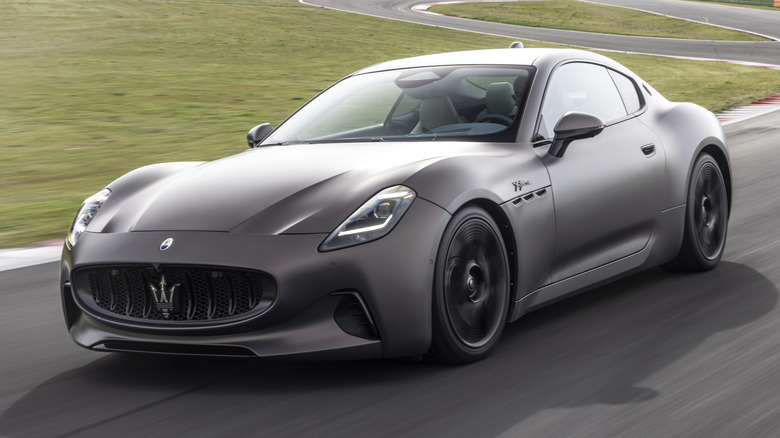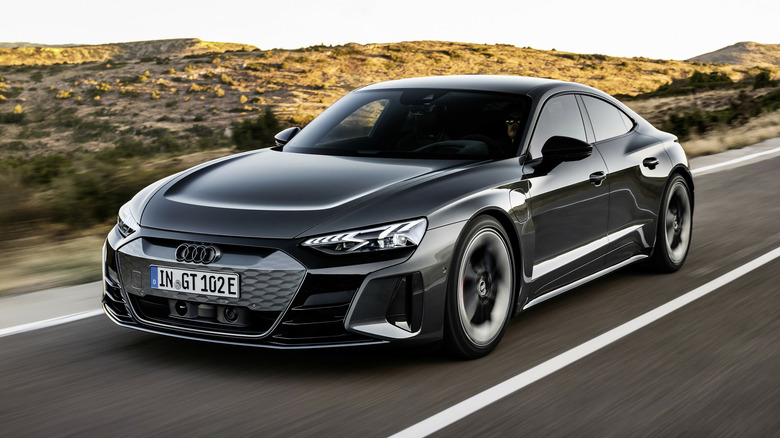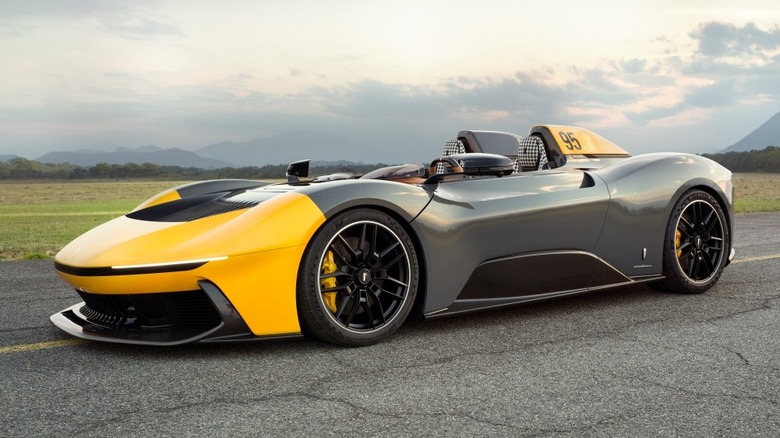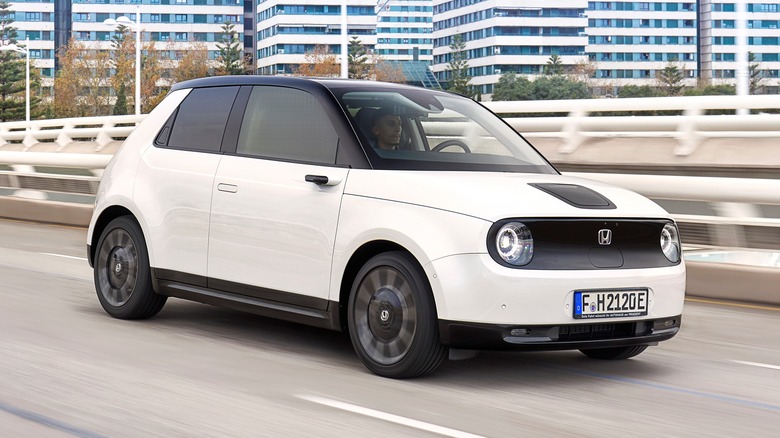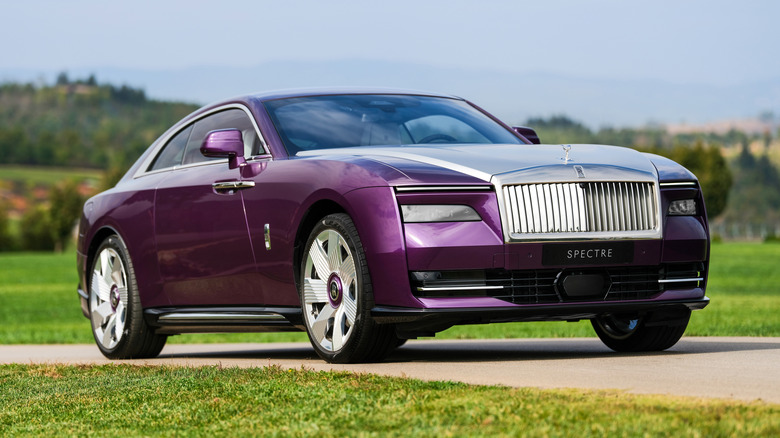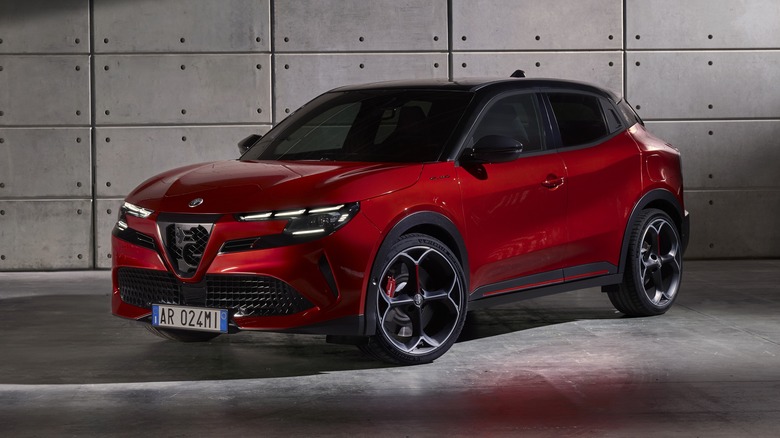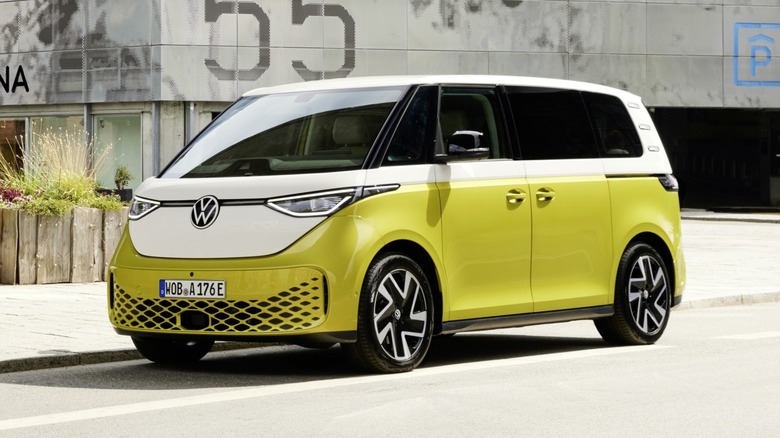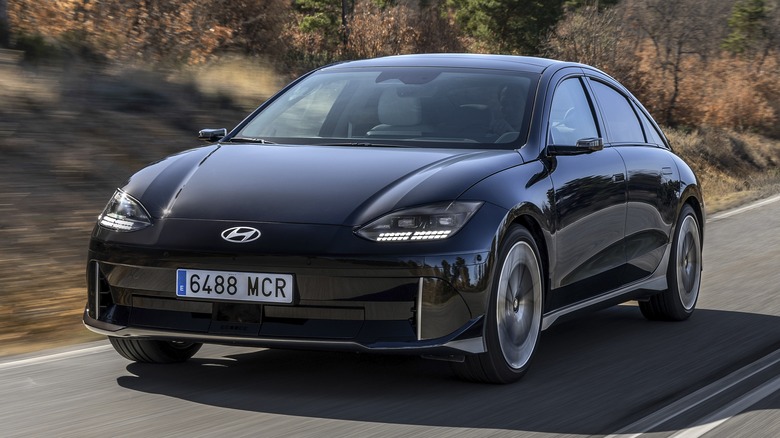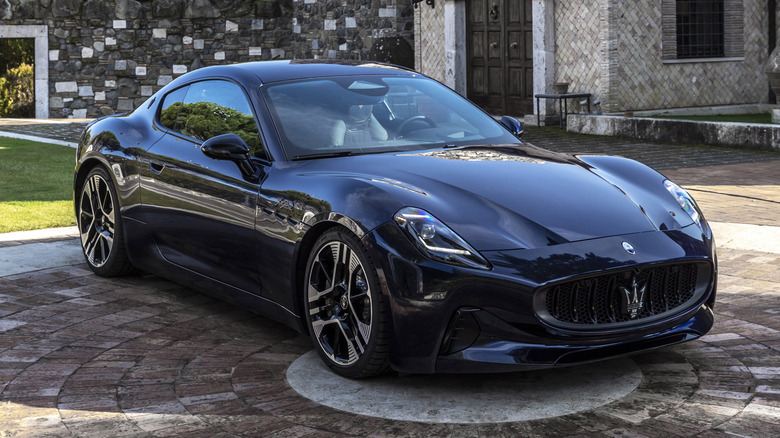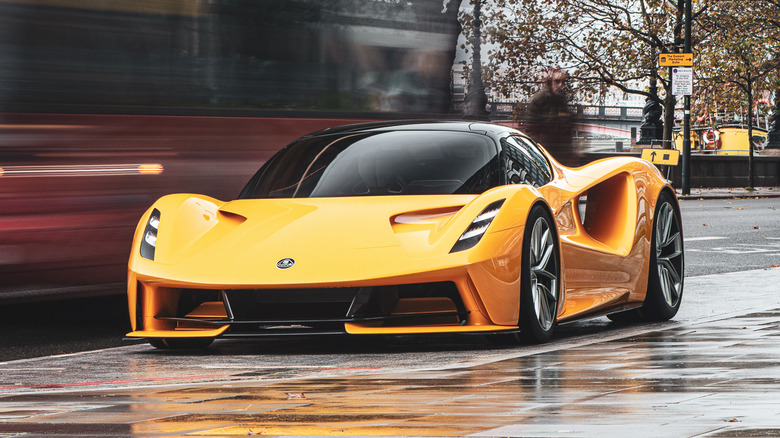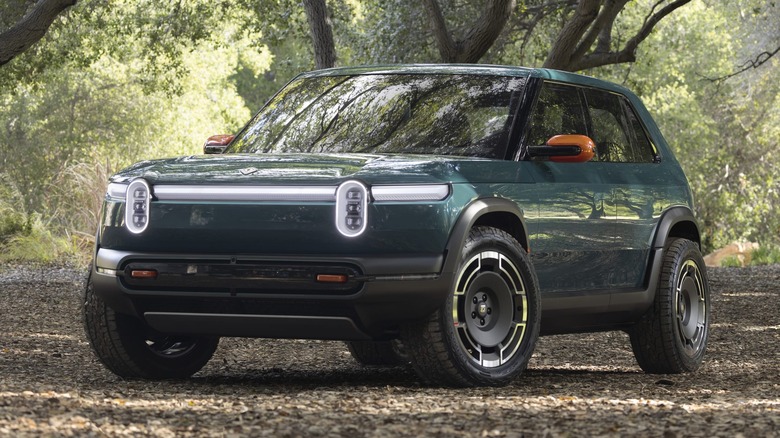10 Electric Cars That Absolutely Nail The Styling
The increasing adoption of electric vehicles has caused plenty of hand-wringing among enthusiasts and automotive traditionalists. Aside from the usual concerns about range, charging times, and longevity, there have been concerns that EVs don't prioritize style as much as their internal-combustion counterparts. While that might have been true for the earliest crop of EVs — few would argue that the original Nissan Leaf was a masterclass in attractive design — it's certainly no longer the case.
With EVs now available in almost every segment of the market, designers have had more opportunity than ever to develop unique and distinctive models. Styling is always subjective, but we think many current cars stand out as particularly great examples of excellent design. SlashGear has rounded up 10 of the very best, covering a wide variety of segments from the temptingly affordable to the wildly unobtainable.
Audi RS E-Tron GT
Considering both cars share the same platform and electric motor, it can be easy to dismiss the Audi RS E-Tron GT as the lesser cousin to the Porsche Taycan. However, in our review, we found driving the Audi to offer a notably different experience, with a more luxurious, GT-like experience, compared to the sharper sports car feel of the Taycan. The RS E-Tron GT is the priciest and most powerful variant of the e-tron GT range, with more than 600 horsepower on offer and a 0-60 mph time right around the 3-second mark.
Put the Porsche and the Audi side by side and it's immediately clear that the two cars are related, but both boast unique enough styling that neither feels like a clone. The Audi in particular manages to keep its styling consistent with other models in the brand's lineup, applying the brand's familiar front fascia to the body of a futuristic, swooping GT.
Many electric cars sit in one of two camps: Either they closely ape the looks of their gas-powered counterparts, or fall into the trap of trying to look different and therefore aren't immediately recognizable as a product of their brand. The RS E-Tron GT does neither, striking an excellent balance between being distinctly new and still gelling comfortably with the rest of Audi's current electric and gas-powered lineup.
Pininfarina B95
First unveiled in 2023, the Pininfarina B95 is the follow-up to the Italian design house's Battista hypercar. It shares many of the Battista's underpinnings, which in turn are borrowed from Rimac. It's even more exclusive than its predecessor, with a maximum of 10 units built and a starting price of around $4.7 million (4.4 million euros).
Each buyer will work with Pininfarina to design the car to their tastes, with the option to customize everything from the color of the interior stitching to the wheels. No two examples of the car will look alike, but they'll all share one thing in common — the ability to draw a crowd even in a lineup of other hypercars. Pininfarina calls the B95 the world's first "hyper barchetta": While other recent hypercars like the Ferrari Monza SP2 and McLaren Elva have adopted the same barchetta styling, none have come close to matching the B95's 1,900 horsepower power output.
There's something innately fascinating about a car with no roof, windows, or windshield — perhaps it's the image of golden-era racers that such a car evokes, or perhaps it's simply the sheer novelty of something so powerful and so impractical. Either way, the B95 is a testament to the fact that the most niche body styles beloved by enthusiasts and collectors won't be going anywhere in the new era of electrification.
Honda e
If ultra-exclusive, multi-million dollar hypercars represent one end of the EV spectrum, the Honda e surely represents the opposite end. It's small, practical, and designed with everyday driving in mind. Yet, unlike many affordable EVs, it doesn't fall victim to the generic crossover trend. Instead, Honda managed to create a retro-futuristic EV that incorporates design motifs from the brand's heritage without purely relying on nostalgia.
Other carmakers have tended to lean more heavily on the nostalgia element — the upcoming Renault 5 EV, for example, resurrects one of the brand's best-known nameplates and copies the original's design as closely as possible. Honda could likewise have gone for this easier route, reviving a retro nameplate and capitalizing off its legacy, but instead took the admirable route to make a retro-inspired, but ultimately unique car. However, it might have nailed the styling, but unfortunately, a limited range and high starting price put it at a disadvantage in Japan and Europe's fiercely competitive small car market. With slow sales, the e faces the axe in 2024 after just four years on sale. Even with its flaws, though, the e remains one of Honda's best electric cars so far.
Rolls-Royce Spectre
With so many other luxury manufacturers entering the space, it seemed inevitable that Rolls-Royce would eventually make an EV. What was less certain, however, was just how well such an EV would line up with buyers' expectations. Making, in the most literal sense, the Rolls-Royce of EVs is no straightforward task, but after our first drive with the Spectre, it seems there was no need for concern. The car delivers everything the most discerning owner could want, with the same exquisite attention to detail and laundry list of bespoke options as other models in the brand's lineup.
The Spectre delivers a ride just as unwaveringly smooth as a Phantom or a Ghost, feeling most at home racking up the miles on the open road rather than in the twisties. This similarity to its gas-powered counterparts is reflected in the car's huge, imposing, and yet still elegant look. It's significantly longer than its predecessor, the Wraith, but notable similarities can be seen in both the Spectre's side profile and at the rear.
Unlike some other luxury cars, the Spectre also manages to look good in a wide variety of colors. Less adventurous buyers might be content to stick with a white, gray, or black finish, but to design a luxury barge that looks good in the Chartreuse green and bright purple of our test cars is no mean feat.
Alfa Romeo Junior
Many brands choose to unveil a large, high-margin luxury SUV or sedan as their first foray into the world of EV manufacturing. Alfa Romeo could have done exactly that — parent company Stellantis already makes the Maserati Grecale Folgore, which could have been easily rebadged — but it chose not to. Instead, the brand has unveiled a smaller, cheaper crossover that shares a platform with the Europe-only Jeep Avenger and Fiat 600e. It arguably looks better than both of its Stellantis stablemates, with plenty of characteristic Alfa flair.
This is set to be the smallest vehicle in the brand's lineup and promises to be an important model in Alf Romeo's history, whether or not it's successful in showrooms. That's because it's reportedly being positioned by bosses as the brand's volume seller. If it lives up to expectations, it could help shape the future of the brand. As such, it's a relief to see that the car offers the same level of sharp, sporty styling that Alfa enthusiasts have long admired.
Designing something befitting of the Italian brand on a platform so compact and upright is an accomplishment in itself, especially given the aerodynamic considerations that had to be made to achieve the car's 250 miles of range. The market demand for crossovers and SUVs of all sizes seems to be insatiable, and so if Alfa Romeo has to make a small crossover to keep its bottom line healthy, at least it looks like a proper Alfa should.
Volkswagen ID.Buzz
The ID.Buzz is the latest entry in the long history of Volkswagen vans, and the first to be fully electric. Rather than take design inspiration from its direct predecessor, the T6, the ID.Buzz goes back to the van's roots and borrows as much of its styling as possible from the original Type 2. Unlike the T6, which never made it stateside, the ID.Buzz is set to arrive in U.S. dealerships in 2024. Unashamedly borrowing the styling cues from an iconic classic isn't always a good idea — get it wrong and it can look like you've run out of ideas as a brand. The ID.Buzz pulls it off with aplomb.
The van looks distinctive and contemporary, but there's no mistaking its heritage. It's fun and different, but never to the point where it compromises its practicality as a family-hauling van. Perhaps there's no better evidence as to how well VW has managed to strike the right balance than the ID.Buzz's sales success: In 2023, it was reported that the waitlist for certain variants of the van stretched as long as 18 months. Minivans as a whole are far from the most popular cars in today's market, but maybe that's because most of them don't look anywhere near as funky as the ID.Buzz.
Hyundai Ioniq 6
Hyundai's rapid rise from an also-ran budget carmaker to an innovative automotive powerhouse has been nothing short of remarkable. Arguably, there's no car that better sums up the brand's penchant for innovation than the electric Ioniq 6. It's reasonably priced, boasts a competitive range, and feels great on the road. Plus, it looks unlike any Hyundai before it. Not everyone is convinced that it's a looker — in fact, SlashGear's own chief tester questioned how well the Ioniq 6's styling will age in our review — but even if it's not for everyone, it's still a striking car.
This puts the idea that all efficient, aerodynamic EVs look the same firmly to bed, without relying on styling gimmicks or the overly aggressive, angular looks that some SUV makers have resorted to. The Ioniq 6 backs its unique looks up by being both practical and well-equipped, and its 270-mile range claim proved to be accurate during our time with the car. In short, it's an appealing conventional EV underneath decidedly unconventional styling, and all the better for it.
Maserati GranTurismo Folgore
The original Maserati GranTurismo has received very few styling tweaks since its unveiling in 2007, with the most significant being a refresh in 2018 that overhauled the front bumper. Maserati hasn't sought to reinvent the wheel for the second-generation car, staying close to the original design but subtly updating it for the present day. The result looks just as head-turning as its predecessor, but there's one key difference under its sloping hood. As well as being available as a traditional gas-powered grand tourer, it's now available in all-electric form too.
SlashGear tested both the gas-powered and electric GranTurismo variants in 2023 and we found them to be a notable improvement over the outgoing generation. In particular, the acceleration afforded by the electric GranTurismo Folgore's trio of motors far exceeded what even the most potent gas-powered GranTurismo could offer, without sacrificing the car's long-distance cruising comfort. Those motors can also reportedly handle significantly more power than the GranTurismo Folgore currently produces, making power increases mostly a matter of upgrading the batteries. Even if the Maserati grand tourer is subject to future power upgrades, its elegant, futureproof styling should ensure its exterior remains mostly unchanged, just like its predecessor.
Lotus Evija
The most expensive, and arguably the best-looking Lotus ever built, the Evija is unlike anything the brand has produced. First unveiled in 2019, it still looks cutting-edge today, especially with its cut-out bodywork, which is even more striking in person than in photos. The car wasn't just about looks either, as its roughly 2,000 hp output was unprecedented for an EV when it was first shown to the public. In short, the Lotus Evija set the blueprint for other hypercar makers, and while some have come close to matching its horsepower, none have definitively exceeded it.
Building a hypercar might have seemed an unlikely move for Lotus at the time, but in retrospect, it seems like an obvious path to take on the road to wider electrification. What's less readily explainable is the brand's decision to produce an electric SUV, a direct contradiction to Lotus founder Colin Chapman's ethos of "simplify, then add lightness." The Eletre SUV might be a boon for the brand's bean counters, and perhaps a necessary move to ensure its future survival, but its chunky stature and almost insectoid front headlights surely would have benefitted from taking a little inspiration from the Evija.
Rivian R3X
One of the key challenges for any startup carmaker is how to create a unique, distinctive design language with no prior heritage to draw from. It's a tricky balance to get right: Pull too much inspiration from other carmakers and you might be accused of ripping them off, but play it too safe and the resulting design might veer into the generic. Rivian has done an excellent job of creating a distinctive look for its cars and trucks since its inception. And as the R3X crossover proves, its design language works well on all manner of cars.
The R3X channels the retro, boxy hot hatch design of the '70s that gave birth to icons like the original Volkswagen Golf, but adds the unique headlight and taillight design that first appeared on Rivian's R1T pickup truck. The wider wheel arches and beefier tires add a slight rally-inspired look to the car, though there are currently no details on whether the R3X will pack a sporty powertrain to match its looks. It's not set to go on sale for several years yet — the company is concentrating on the global rollout of its R2 SUV first — but when it does, it's set to be the most affordable Rivian to date, with a starting price of less than $45,000.
